#Data Destruction Techniques
Explore tagged Tumblr posts
Text
Data Destruction Secrets Exposed: What They Don't Want You
Introduction:
In today's digital age, data is currency, and we're all vulnerable to potential data breaches and cyber threats. Whether you're an individual or a business, your sensitive information can be a goldmine for malicious hackers. That's why data destruction is critical – it's the ultimate shield to protect your secrets. But, what if I told you there are data destruction secrets they don't want you to know? In this eye-opening article, we'll reveal the hidden truths about data destruction and how you can take charge of your data security.
The Dirty Truth Behind "Delete" Buttons:
You might think clicking that "delete" button is enough to erase your files permanently. But here's the shocking truth: it's not! Data deleted conventionally can often be recovered with basic data recovery software. Cybercriminals love this vulnerability, and they're just waiting to get their hands on your discarded information.
Formatting: A False Sense of Security!
Have you ever formatted a hard drive, thinking you've wiped it clean? Brace yourself for this revelation: formatting only removes the file system, leaving the actual data intact. With the right tools, your private files can still be retrieved with ease. Don't let formatting lull you into a false sense of security.
Thrift Store Treasures: A Hacker's Paradise!
Did you know that old electronic devices you donate or sell can be a goldmine for data thieves? The information you thought was gone forever might still be lurking on that old smartphone or laptop. Don't let your carelessness become a hacker's paradise – discover how to truly obliterate data before saying goodbye to your gadgets.
The Art of Overwriting: Your Ultimate Weapon!
Enter the world of true data destruction: overwriting! By using specialized data wiping software, you can overwrite your storage devices with random data patterns, making the original information unrecoverable. This powerful technique ensures that your data is genuinely gone forever, leaving hackers empty-handed.
Demystifying Degaussing: The Magnetic Erasure!
Ever heard of degaussing? It's the clandestine method used by security experts to neutralize magnetic storage media. By erasing magnetic fields, degaussing leaves data irreversibly scrambled, thwarting any data-recovery attempts. Uncover the secrets of degaussing and add another layer of protection to your sensitive data.
Conclusion:
Now that you know the shocking truths about data destruction, you have the power to protect yourself and your valuable information. Don't be fooled by the simplicity of "delete" buttons or the illusion of formatting. Embrace the true techniques of data destruction, like overwriting and degaussing, to ensure your privacy and security are never compromised.
Knowledge is power, and now you're equipped with the knowledge to safeguard your digital world. Take charge of your data security and don't let the secrets of data destruction remain hidden any longer. Stay one step ahead of cybercriminals and protect what matters most – your data, your secrets, and your peace of mind!
0 notes
Text
Dandelion News - February 22-28
Like these weekly compilations? Tip me at $kaybarr1735 or check out my Dandelion Doodles! (This month’s doodles will be a little delayed since I wasn’t able to work on them throughout the month)
1. City trees absorb much more carbon than expected

“[A new measurement technique shows that trees in LA absorb] up to 60% of daytime CO₂ emissions from fossil fuel combustion in spring and summer[….] Beyond offering shade and aesthetic value, these trees act as silent workhorses in the city’s climate resilience strategy[….]”
2. #AltGov: the secret network of federal workers resisting Doge from the inside
“Government employees fight the Trump administration’s chaos by organizing and publishing information on Bluesky[…. A group of government employees are] banding together to “expose harmful policies, defend public institutions and equip citizens with tools to push back against authoritarianism[….]””
3. An Ecuadorian hotspot shows how forests can claw back from destruction

“A December 2024 study described the recovery of ground birds and mammals like ocelots, and found their diversity and biomass in secondary forests was similar to those in old-growth forests after just 20 years. [… Some taxa recover] “earlier, some are later, but they all show a tendency to recover.””
4. Over 80 House Democrats demand Trump rescind gender-affirming care ban: 'We want trans kids to live'

“[89 House Democrats signed a letter stating,] "Trans young people, their parents and their doctors should be the ones making their health care decisions. No one should need to ask the President’s permission to access life-saving, evidence-based health care." "As Members of Congress, we stand united with trans young people and their families.”“
5. Boosting seafood production while protecting biodiversity

“A new study suggests that farming seafood from the ocean – known as mariculture – could be expanded to feed more people while reducing harm to marine biodiversity at the same time. […] “[… I]t’s not a foregone conclusion that the expansion of an industry is always going to have a proportionally negative impact on the environment[….]””
6. U.S. will spend up to $1 billion to combat bird flu, USDA secretary says
“The USDA will spend up to $500 million to provide free biosecurity audits to farms and $400 million to increase payment rates to farmers who need to kill their chickens due to bird flu[….] The USDA is exploring vaccines for chickens but is not yet authorizing their use[….]”
7. An Innovative Program Supporting the Protection of Irreplaceable Saline Lakes

“[… T]he program aims to provide comprehensive data on water availability and lake health, develop strategies to monitor and assess critical ecosystems, and identify knowledge gaps to guide future research and resource management.”
8. EU to unveil ‘Clean Industrial Deal’ to cut CO2, boost energy security

“The bold plan aims to revitalize and decarbonize heavy industry, reduce reliance on gas, and make energy cheaper, cleaner, and more secure. […] By July, the EU said it will “simplify state aid rules” to “accelerate the roll-out of clean energy, deploy industrial decarbonisation and ensure sufficient capacity of clean-tech manufacturing” on the continent.”
9. Oyster Restoration Investments Net Positive Returns for Economy and Environment

“Researchers expect the restored oyster reefs to produce $38 million in ecosystem benefits through 2048. “This network protects nearly 350 million oysters[….]” [NOAA provided] $14.9 million to expand the sanctuary network to 500 acres by 2026 […] through the Bipartisan Infrastructure Law.”
10. Nations back $200 billion-a-year plan to reverse nature losses

“More than 140 countries adopted a strategy to mobilize hundreds of billions of dollars a year to help reverse dramatic losses in biodiversity[….] A finance strategy adopted to applause and tears from delegates, underpins "our collective capacity to sustain life on this planet," said Susana Muhamad[….]”
February 15-21 news here | (all credit for images and written material can be found at the source linked; I don’t claim credit for anything but curating.)
#hopepunk#good news#carbon capture#climate change#trees#altgov#us politics#resistance#government#doge#bluesky#reforestation#ecuador#gender affirming care#trans rights#protect trans kids#seafood#biodiversity#farming#fish farming#bird flu#usda#great salt lake#migratory birds#science#clean energy#european union#oysters#habitat restoration#nature
111 notes
·
View notes
Text
Libraries have traditionally operated on a basic premise: Once they purchase a book, they can lend it out to patrons as much (or as little) as they like. Library copies often come from publishers, but they can also come from donations, used book sales, or other libraries. However the library obtains the book, once the library legally owns it, it is theirs to lend as they see fit. Not so for digital books. To make licensed e-books available to patrons, libraries have to pay publishers multiple times over. First, they must subscribe (for a fee) to aggregator platforms such as Overdrive. Aggregators, like streaming services such as HBO’s Max, have total control over adding or removing content from their catalogue. Content can be removed at any time, for any reason, without input from your local library. The decision happens not at the community level but at the corporate one, thousands of miles from the patrons affected. Then libraries must purchase each individual copy of each individual title that they want to offer as an e-book. These e-book copies are not only priced at a steep markup—up to 300% over consumer retail—but are also time- and loan-limited, meaning the files self-destruct after a certain number of loans. The library then needs to repurchase the same book, at a new price, in order to keep it in stock. This upending of the traditional order puts massive financial strain on libraries and the taxpayers that fund them. It also opens up a world of privacy concerns; while libraries are restricted in the reader data they can collect and share, private companies are under no such obligation. Some libraries have turned to another solution: controlled digital lending, or CDL, a process by which a library scans the physical books it already has in its collection, makes secure digital copies, and lends those out on a one-to-one “owned to loaned” ratio. The Internet Archive was an early pioneer of this technique. When the digital copy is loaned, the physical copy is sequestered from borrowing; when the physical copy is checked out, the digital copy becomes unavailable. The benefits to libraries are obvious; delicate books can be circulated without fear of damage, volumes can be moved off-site for facilities work without interrupting patron access, and older and endangered works become searchable and can get a second chance at life. Library patrons, who fund their local library’s purchases with their tax dollars, also benefit from the ability to freely access the books. Publishers are, unfortunately, not a fan of this model, and in 2020 four of them sued the Internet Archive over its CDL program. The suit ultimately focused on the Internet Archive’s lending of 127 books that were already commercially available through licensed aggregators. The publisher plaintiffs accused the Internet Archive of mass copyright infringement, while the Internet Archive argued that its digitization and lending program was a fair use. The trial court sided with the publishers, and on September 4, the Court of Appeals for the Second Circuit reaffirmed that decision with some alterations to the underlying reasoning. This decision harms libraries. It locks them into an e-book ecosystem designed to extract as much money as possible while harvesting (and reselling) reader data en masse. It leaves local communities’ reading habits at the mercy of curatorial decisions made by four dominant publishing companies thousands of miles away. It steers Americans away from one of the few remaining bastions of privacy protection and funnels them into a surveillance ecosystem that, like Big Tech, becomes more dangerous with each passing data breach. And by increasing the price for access to knowledge, it puts up even more barriers between underserved communities and the American dream.
11 September 2024
154 notes
·
View notes
Text
Take note, all those who live in hurricane areas.



If you live in any of these areas in red, be prepared on all your weather alerts, particularly those in hurricane areas this summer and fall.

The National Weather Service is in worse shape than previously known, according to interviews with current and former meteorologists, due to a combination of layoffs, early retirements and preexisting vacancies.
The nation’s forecasting agency is in tatters as what could be a destructive hurricane season nears. Several current and former agency meteorologists told CNN they are concerned forecasts and life-saving warnings are not going to be issued in time.
Responsible for protecting life and property from severe weather impacts, the National Weather Service is headed into hurricane season with 30 of its 122 weather forecast offices lacking their most experienced official, known as the meteorologist-in-charge.
These include offices that cover major population centers such as New York City, Cleveland, Houston and Tampa.
There is not a single manager in place at the hurricane-prone Houston-Galveston forecast office, according to a NOAA staff member who requested anonymity for fear of reprisal.
That office was the main source of information during Hurricane Harvey, which killed at least 68 people, dumped a record 60.58 inches of rain and flooded large parts of the Houston metro area in 2017.
Already, multiple offices have reduced or eliminated daily weather balloon launches and more are likely to follow suit following a wave of early retirements taking place this week, the NOAA employee said. The balloons provide critical data for computer models that forecasters use to predict the weather, raising the likelihood that projections will be more unreliable.
One NWS forecast office, in Goodland, Kansas, is no longer operating 24/7, with about a dozen more likely to shift to non-24-hour operations if action isn’t taken this month. These offices include several in the Plains states and stretch into the Pacific Northwest.
Such a change is virtually unheard of in the absence of an extreme weather event, such as a hurricane or tornado, that either threatens the lives of the forecasters themselves or knocks them offline.
There are also more than 90 vacancies among the staff responsible for repairing NWS Doppler radars and automated surface weather observation stations, the NOAA staff member said, greatly raising the likelihood of prolonged equipment outages that could affect air travel. Weather stations provide pilots and controllers with crucial data on wind direction and speed at airports to determine how to take off and land safely, among other parameters.
Radar outages during tornado and hurricane seasons could cause forecasters to miss hazardous conditions till after they strike.
The NWS has lost more than 550 people all told, since the start of Trump’s second term, according to tallies kept by sources inside and outside of the agency. That’s about the same number as the agency lost in the 15 years between 2010 and 2025, according to Tom Fahy of Capitol Meteorologics.
Of the hundreds of vacancies, the 30 open meteorologist-in-charge roles are particularly worrying, current and former NWS meteorologists told CNN.
Meteorologists-in-charge serve as the captain of a team of forecasters and other specialized staff members. Their decades of experience often comes into play during high-impact weather situations, an active-duty NWS meteorologist told CNN. They also requested anonymity for fear of reprisal.
“They’re usually the glue that holds it together,” the NOAA staff member said of these chief meteorologists.
These leaders work forecast shifts when needed, interpret guidance coming from NWS headquarters, and help push their forecasters to adopt new technology, forecast and warning techniques, said a weather service employee who also requested anonymity because they were not authorized to speak to the press.
“The MICs are the critical linchpin in the operation of our weather forecast offices,” said former NOAA administrator Rick Spinrad, using the acronym for these managers. “They ensure the forecasters have all they need to be most effective, and they are the direct link to NWS HQ for safe and timely communications during weather events,” Spinrad, who led NOAA during the Biden administration, told CNN.
[...]
With FEMA limping into hurricane season with staff vacancies of their own, the state and local emergency management interactions that meteorologists in charge typically have may be even more important during the coming months.
“They too are meteorologists and often fill shifts when folks are sick or on vacation or there are vacancies,” the NWS employee said, and their absence makes it harder to fill those shifts and keep the lights on.

10 notes
·
View notes
Text
The GF13-017NJ Shining Gundam
Love, honor, sacrifice, revenge, and a whole lot of destruction!
Let's get things started!
Gundam fight, all set!
Ready...
Go!
In the Future Century, war is widely considered a thing of the past. Earth's space colonies settle their differences every four years in the ring, using hulking battle-machines called Mobile Fighters. A long-held tradition between the colonies, the Gundam Fight has encouraged the development of many unique and powerful machines.
During the 12th Gundam Fight in FC 56, Neo-Japan deployed a Gundam whose name and designation remain unknown. The machine was piloted by Ulube Ishikawa. Despite making it to the finals, Ulube's Gundam was defeated by "The Undefeated of the East", Master Asia, representing Neo Hong Kong in the Kowloon Gundam.


Further development and refinement of the machine by Neo Japan's Dr. Mikamura would go down two paths.
One of these paths would lead to the first of two machines used by Domon Kasshu to represent Neo-Japan in the 13th Gundam Fight. The GF13-017NJ Shining Gundam.



Designed with a focus on speed and mobility, the Shining Gundam is a terror at close-range. The machine featured a system with which its performance could be increased exponentially, enabling the use of more powerful techniques by its pilot. The machine also drew power from the emotions of its operator, channeling them into attacks to devastating effect.
Like most Mobile Fighters, the Shining Gundam was operated via the Mobile Trace system, a system through which the pilot's physical movements would directly operate the machine.
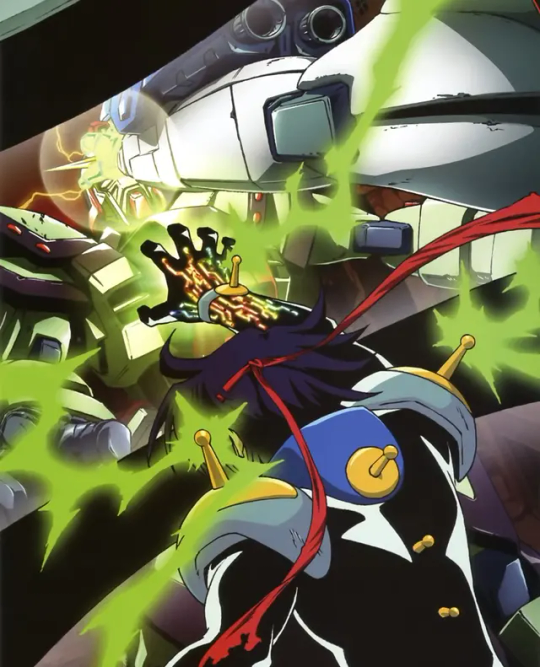
Notably, another variant of the Shining Gundam was developed. This "Urban Combat Type" featured an alternate color scheme.

I won't be covering the God Gundam here. I think it deserves a piece of its own sometime down the line.
The following information comes from the manga Super-Class! Mobile Fighter G Gundam. Its events do not line up with the events of the anime Mobile Fighter G Gundam.
The Shining Gundam was also refined into the JMF1337SD Shading Gundam, a fully-automated machine based on spare parts for the original. The machine was piloted by its "Data-Kyoji" system, which could learn and grow in response to its experiences. It was also capable of using the techniques of Domon Kasshu, having been specifically developed to combat him.

Having been sent to Earth under orders from the Neo-Japan Gundam Fight Committee chairman, Karato, the machine was intended to cripple Domon following his unsatisfactory performance early in the tournament. The Data-Kyoji was then to be installed in the Shining Gundam, keeping Domon on board for authentication with the machine interface.
The machine was unable to make use of Super Mode, as it lacked the ability to channel the intense emotions required to attain the state.
The GF13-017NJ Shining Gundam was originally designed by Kunio Okawara for the 1994 anime Mobile Fighter G Gundam.
This machine was a request! Requests are always welcome!
19 notes
·
View notes
Text
Day 64 (2/3)
Eleuthia-9
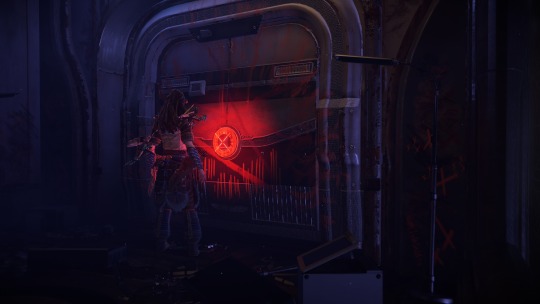

This was the door they could never pass, sealing away the other chambers of the Cradle, within sight but out of reach. They scored the door with angry red crosses in their rage. I passed through without problem.


Inside were workstations, each equipped with a Focus, sitting here untouched for centuries. I picked up all those that were still functioning for later use. I'll use Sylens' technique of backing up data to other Focuses as well. They're fragile things. Each Focus held only one message, an address from Samina Ebadji welcoming the children to Apollo and the beginning of their education. Then the message cut out, a voice saying that Apollo was offline. Sylens was eager for a way to bring it back online again. If there is one, I'll try to restore it, but finding out the truth about Gaia and my origins is more important.

Further on there was a hologram projector; a smaller version of those in the Zero Dawn facility. The machine announced a priority message for Elisabet Sobeck. For me.

Unlike the other holograms, this one covered the entire room; it was like being transported somewhere else. Darkness all around, and a glowing dome like the scanning radius of a Focus. The subordinate functions appeared first, each emitting a ray of holographic icons that coalesced to form Gaia. This time, nearly a millennia after her initial conception, she resembled the form from Elisabet's presentation, her dress shifting between shades, her movements like that of a human.


Gaia spoke of an unknown transmission that struck her systems—as sudden as a bolt of lightning, by the images she showed me. She said it...transformed her subordinate functions into intelligent, distinct, self-governing entities. Made them into AIs? I didn't know they could be created so quickly. From the data I've found, it used to take years, and they had to learn, but the functions were given intelligence and will out of thin air.
Given control over its own actions, Hades activated itself and began taking control away from Gaia as it was meant to in the event of a botched biosphere. By reversing terraforming operations, it could render life extinct in fifty days. To prevent this, Gaia resorted to destroying herself and Hades with her. This would buy time, but eventually the terraforming system would break down without a central governing intelligence. She said it would become 'increasingly erratic' in the meantime—the Derangement, I gathered, and the chaotic weather too.


Her solution was to generate a...reinstantiation of her creator. A copy; a clone. She said that 'high-level directives' prevented her from communicating directly with humans. I wonder why—is it because Apollo is offline, or was she never intended to speak to us in the first place? Gaia hoped that I would reenter the Cauldron in adulthood—perhaps the scan wouldn't have worked when I was young—take one of the Focuses and use it to view her message to me. From there I would be able to enter the other ruins of Zero Dawn facilities across the lands and repair the terraforming system before it was too late.
Gaia spoke to me as if I was Elisabet, used her name, relied on and believed in me as if I really was her. Did she understand that I'm not—that I don't remember, don't know anything about how to fix her?
Repair couldn't come until after Hades' destruction anyway, or it would only attempt to resume where it left off. Gaia directed me to the 'master override'—a tool in the facility where she operated from for all those centuries. With it, I would be able to purge Hades permanently.


Before Gaia could finish her instructions, Hades made its move in response to its imminent destruction. It dissolved the 'shackles' keeping it and the other subordinate functions within the system. They fled from Gaia's reach, escaping. Then Hephaestus wasn't the only other function to escape—they're all out there, hiding in ancient ruins, wreaking havoc wielding ancient machines. Are they all as dangerous and murderous as Hephaestus?
In its final act before fleeing itself, Hades corrupted data throughout Gaia's systems, including the Alpha registry in the Cradle. From that, Gaia knew I wouldn't be able access her instructions. Her final words as she burnt away into embers, the explosion destroying her central intelligence as her functions soared free, were words of hope. She believed that I, Elisabet, could succeed against the odds, as I once did long ago.
I guess she was right.

As the hologram faded out, it hit me all at once. I was never a person, just a tool forged with intent, something Gaia made to fix her systems in the fire of her death. There was never anyone waiting for me. The curse that the Nora speak of really did begin at my birth—the machines going rabid, the world spinning into chaos. Made by a machine to remake that machine that I once made in a life I can't remember.
Sylens snapped me out of it. There were two sides to this revelation. I have a mission, a purpose, and my path forward is clear. It's the only path. If I don't walk it, everything will die. Gaia was my mother, in a way, and Elisabet was too.


When I exited the hatch, half the onlookers were already kneeling. When Teersa asked me if I spoke to the goddess, I could find no better way to explain the truth. I was born to lift a curse, I told her. I was born to kill Hades, the Metal Devil of a new age.


Before I could stop them, the Matriarchs declared me Anointed of the Nora, calling for the faithful to praise me. They all fell to their knees, heads and palms pressed against the ground. Maybe I should have just stood there and taken it, but I couldn't. The anger I'd been harboring all my life came to the surface and I yelled at them, grabbed them, hoisted them to their feet, as many as I could reach. All those years they shunned me, ignored my existence or worse, and now they're using those very same backwards, cruel, nonsensical myths to set me apart above instead of below, call me their saviour, their prophet, theirs. I never was, and I never will be.
For centuries they've stayed here, kissing the ground that spat them out into a world that wasn't ready, forcing fear and ignorance onto all their people. I won't represent that.

I knew they would listen to me, for better or for worse, and so I told them what I'd learned. There's a whole world out there. Not a valley, not the sightlines of a single mountain, a world larger than they can imagine all coming to an end, full of people who deserve to be saved, no less favoured by the 'goddess' who created them. I told those who could fight to meet me in Meridian to do battle against the Eclipse when they launched their invasion. I thought it was a long-shot, but having been proven right, Teersa was looked to by the other Matriarchs to give orders. She bid them follow me into the west. I suppose they'll justify it by saying the blessing of an Anointed is far more powerful than the blessing of a mere Seeker.

I sought out Teersa once the crowd dispersed, though I could still feel their eyes on me. Even if Teersa's faith clouds her true understanding of what I am and why I was made, she's still the only reason I wasn't left in the wilds to die as an infant, and she's been kind to me. She always believed in me.
She told me Rost's story as well, finally. As the Anointed, which I guess is a thing, she didn't have much of a choice. What are oaths before the will of the goddess?
Rost committed no crime. Instead, he became a Death Seeker in a Nora rite that separates soul from body��whatever that means—to preserve the soul in All-Mother's protection while the body wanders from her sight. Once gone, the body is never permitted to return. Rost went through this ordeal to seek vengeance for a group of hostages taken and slain by outlanders, their corpses left in open mockery just across the border of the Sacred Lands. Teersa said the tribe never discovered who the outlanders were or what they wanted, but they delved in the ruins of Devil's Thirst, emitting strange, metal noises in their search. One of the hostages was Rost's six year old daughter, Alana. He never said.
On his quest for revenge, he journeyed north to Ban-Ur, further west to the Claim, through the Sundom and further still, to Utaru lands and Tenakth, then even deeper into the Forbidden West. He killed all twelve of the outlanders for their crimes. Rost returned to the Sacred Lands on the brink of death. He didn't even make it over the border on his own; another Nora broke taboo to drag him across. Law said he should have been left for dead, but knowing all that he had sacrificed for the tribe, the tribe couldn't follow through. They nursed him back to health and the Matriarch's 'compromise', in their infinite generosity, was to outcast him for life. Can't have a man without a soul in your village, that's just logical. And convenient, when the time came to get rid of me. Instead of leaving me to die, they left me in the care of a man who had lost a young daughter of his own. Teersa saw wisdom in that act, not cruelty, and said she was grateful for all Rost had done to raise and train me in the ways of Nora faith. He was so devout, I suppose no one else could have done better. I must just be resistant to that sort of thing.
Talking about Rost brought back old feelings. I should go and visit him again.
And I thought of Olin, too. Both Rost and I embarked from the Sacred Lands seeking revenge, but while the twelve outlanders displayed plain, remorseless cruelty—at least the way Teersa told it—Olin only obeyed the Eclipse to protect his family. His own young child. Killing him was a senseless act. Maybe's Rost's revenges were senseless too—the outlanders were unlikely to return, and all that was preserved in their continued existence was the injustice, the unhealed wounds of pride. He did it for the honour of the tribe, that nebulous thing. I thought myself distant from it, yet bent to its demands like all the rest. If I had let Olin live, he would have helped me take on the Eclipse. I had nothing to gain in slaying him, and far more to lose.
No sense in dwelling on it. There are worse crimes; I believe he forgave me.

I went to Lansra next. It was difficult to ignore her, with her wailing for my forgiveness as I walked past, bowing her head and raising her arms in half cower, half worship. She lamented her misreading of the signs—honestly I was expecting her to double down and say I'd gone into All-Mother's domain to plant a curse in her core. With the rest of the tribe against her, it's hard to tell whether she earnestly believes she was wrong, or is just going along to maintain her position. But she's likely too stupid for such elaborate deception. She doesn't think, doesn't care to look—just fears and lashes out against all things new or confusing to her. She grovelled, begged, touched her head to the floor in supplication. I couldn't stand it. I tried to tell her to open her eyes, to try and learn, but she took my advice literally. I told her to shut her mouth. She took that literally too. All of a sudden the cave was far more peaceful.

I met Arana and her father nearby. Thok tried to stop Arana from speaking so openly to the 'Anointed'. Great, more reasons for the Nora not to speak to me. I assured them it was alright, and to drop the titles, but I'm not sure they will. Arana brought her mother's spear all the way to the mountain, and I thanked them again for the improvements they made to my own.


I took some enjoyment in facing Resh as well. He stuck to his principles where Lansra failed to. Now that the tribe had accepted me as their figurehead, it was his tribe no longer. He said he would be leaving these lands first chance he got. Who's the outcast now?
I also spoke to Teb again, and though I tried to dissuade him from calling me the Anointed, he did so only outwardly. I could tell he idolised me, but he had done so since the Proving; my entering the mountain only solidified his belief. I asked him to stay here in the Embrace, at least, but he refused and said he would join me in Meridian. It would be a shame to see him killed for a cause I promoted after saving his life all those years ago. I wish he'd just stay safe.


Varl was waiting further on. He said he would join me in Meridian, and I would've expected no less of him, but what I did expect was...some sort of curiosity. I offered to show him the inside of the mountain, but he shut that down quick. Even my offer to tell him what I'd learned, to explain my mission, he said he would hear only if the 'goddess willed it'. I thought he was different to the others, that maybe...I thought I could rely on him, that's all. But he's just as willfully ignorant as the rest.


I couldn't stay after that, especially not with all the Nora staring, whispering prayers as I passed. I left the mountain and walked through the cooling ruins of Mother's Watch, taking the long way around to Rost's lodge on the western side of the cliffs enclosing the Embrace. Walking these roads now is even stranger than before. It's not just the charred ruins, the corpses of Deathbringers dotting the valley, it's what this valley means. What all of it means. It was on these lands that the first people born into a new world stepped, and made sacred. Everything that came after was made from the stories they spun to explain their existence. Only Sylens and I know the truth.
#again with the lore. god damn#her reactions to varl were heartbreakinggg. thank you remaster for giving the characters expressions#I could have squashed into 2 but eh#hzd#horizon zero dawn#aloy#aloy sobeck#aloysjournal#hzd remastered#photomode#virtual photography#horizon
8 notes
·
View notes
Text





I've been thinking about this all week. There are a lot of threads and puzzle pieces floating around in my head, but I can't put them together in a satisfying way.
The most likely scenario I have is this:
The OXA machine is likely derived from Vex influence, like the Device created by Ishtar. That would explain how the Vex have data on it in the first place and why both machines are practically identical. The Vex are pervasive, so it's likely that the Psions have encountered them while they were free, or Otzot used Vex tech when they rebuilt it after its destruction after their enslavement. Using the OXA machine to guide them and the Sol Divisive's research, Otzot seeks to reverse-engineer the mind-melding technology used by the Witness (successful attempt) and Maya (failed attempt) to become a God-Thought, a term used by Psions (or at least a Psion under Caiatl) when referring to powerful psychic leaders. We already know Psions are capable of merging minds and even bodies. Tazaroc, Niruul, and Ozletc did this when they formed Inotam during the Season of the Dawn, using an "ancient technique."
This makes the most sense, but I feel like there are holes that I can't see. Either way, Micah's Ghost missions are pulling loose threads and using them to start weaving a tapestry. I'm excited!
#destiny 2#destiny#vex#maya sundaresh#otzot#psions#micah 10#OXA machine#i swear i havent seen any talk about Micah's missions#theyre so good and full of lore and info that are clearly setting foundations for stuff
18 notes
·
View notes
Text









𝕸𝖆𝖗𝖗𝖞 𝖒𝖊 <3
#fucktrump#fuckmaga#fuckmusk#maketheworldgreatagain
Simple souls overload as I explode the data banks
'Cause the earth and space gave birth to this paleface
Supreme, linguistic, mental machine
My brain cells swell, the intellects extreme
Fire fills my veins as I proclaim my resistance
To the mind-swapping parasites that feed off my existence
As I, skin the burn to relearn the royal plan
Out beyond the edges in the depths of spirit land
It's authentic, apocalyptic destroyer
Damaging challengers, resurrection, disorder
A monument of crisis, I strikes this, you're dead
Line my nest with your soul, cleansed in bloodshed
Battle ready!
Poets gonna take control
Battle ready!
Souls violate parole
Battle ready!
Violently invade your home
Breaking the bone of those who 'pose
Commanding the mic, striking up a verb-fest
Mass destruction is my function, time to put it to the test
In combat, attacking since way back
In the days I drew praise for the way that I slayed facts
Formulating flows in revolutionary science
It's the catastrophic prophet from the anarchist alliance
Freaking techniques, this creature of speech
We feel the fury of devastation 'cause we tasted defeat
I'm alone on my throne in this universe of fear
Royalty divides my soul, in this role I'm revered
As the pinnacle lyrical master, queen of disaster
I ruin brain fluid the unknown is what I'm after!
Battle ready!
Battle ready!
I'm breaking the bone of those who 'pose
Battle ready!
Poets gonna take control
Battle ready!
Souls violate parole
Battle ready!
Violently invade your home
Breaking the bone of those who 'pose
Shaking up the world, just like the second coming of christ
When I write, thrice divine with this goddess sight
Words will flow, wounds will grow
You know, bones will be exposed from the force that I unload
It's the soul eater! Mic bleeder with the voice of chaos
I got the nectar of the gods flowing from my mental pod
Gather the flock, alarm your block
Tell them the shepherds have come and got the keys to unlock
A holy war, through your veins it courses
More lyrical artillery than the armed forces
Supernatural, styles be volatile
It's the mind manipulator, the war child!
Battle ready!
Poets gonna take control
Battle ready!
Souls violate parole
Battle ready!
Violently invade your home
Breaking the bone of those who 'pose
Come!
Shadow soldiers!
We came to defy, living life as a lie
We embryonic satellites need our freedom to fly
To watch you die! Agonizing cries are heard in stereo
I'm visualizing battlefield scenarios
In the line of fire, watching empires fall
Into attack position, eliminate them all!
My species!
Battle ready!
Battle ready!
Battle ready!
Breaking the bone of those who 'pose
Battle ready!
Poets gonna take control
Battle ready!
Souls violate parole
Battle ready!
Violently invade your home
Breaking the bone of those who 'pose
My species!
My species!
No surrender!
No surrender!
Battle Ready by Otep

#rise rebel resist#otep#gif mood board#gif moodboard#moodboard#12/2024#h a t e#nu metal#fuck trump#fuck maga#fuck musk#x-heesy#fucking favorite#now playing#music#music and art#spotify#YouTuBe
6 notes
·
View notes
Text
So, a tiny cool project that didn't have dick to do with generative AI (In that it was a lot simpler, but still useful) got bullied off the internet because the books it used to gather its data were pirated and people got pissy.
And like, while I previously didn't have much to say about this wrt AI except "Maybe we should just chill," I kinda realize that the backlash against this can lead into a valuable object lesson.
Because like, I've heard a lot of people suggest in response to well-informed folks like @chromegnomes saying "Anything we could do against AI would have a negative effect on fair use" that "Oh, well we should just make those laws apply to AI then."
And I can understand the mindset, cutting the gordian knot and all that. But the thing is, we tried that technique of "It doesn't count if it's on a computer" before. With online filesharing. And it fucked over everyone except the megacorps.
The right to "first sale," the right that lets you share movies/music/ect you bought was basically destroyed in the digital realm due to fears of stuff like Napster torpedoing the music industry.
The catastrophic consequences of this on preservation have been numerous as you are no doubt aware, but the most relevant one is that that destruction of "first sale" is currently being used to destroy the Internet Archive's online library in favor of the publishing industry's predatory ebook pricing/lending model, even with them being very careful to try and avoid it.
Note that a lot of the biggest names in anti-AI-art such as Jon Lam, Karla Oritz and Neil Turkewitz have been directly cheering on the attempts to kill the Archive, but that's neither here nor there.
But, imagine if the anti-AI-art laws, exempting anything using AI from protection by fair use, end up killing projects like this one.
Further, imagine if something like the Wayback Machine ends up using AI as a means of improving its operations in vital and important ways and some assholes like; say; Facebook or Google decide to sue to kill it.
Don't be fooled. There are better ways to defend your livelihood as an artist than putting the copyright noose around another neck.
32 notes
·
View notes
Text
Russian state hackers, perhaps more than those of any other nation, tend to show off. The notorious Sandworm unit within Russia's GRU military intelligence agency, for instance, has triggered unprecedented blackouts and released destructive, self-replicating code. The FSB's ingenious Turla group has hijacked satellite internet connections to steal victims' data from space. But one team of less-flashy cyberspies working on behalf of the Kremlin rarely earns the same notice: Armageddon, or Gamaredon.
The hackers, believed to work in the service of Russia's FSB intelligence agency, aren't known for their sophistication. Yet they have strung together a decade-plus record of nearly constant espionage-focused breaches, grinding away with simple, repetitive intrusion methods, year after year. Thanks to that sheer overwhelming quantity of hacking attempts, they represent by some measures the top espionage threat facing Ukraine in the midst of its war with Russia, according to cybersecurity defenders who track the group.
“They are the most active state-aligned hacker group attacking Ukrainian organizations, by far,” says Robert Lipovsky, a malware researcher at Slovakian cybersecurity firm ESET.
ESET has tracked Gamaredon as it's breached the networks of hundreds of victims in Ukraine, stealing thousands of files on a daily basis, Lipovsky says. “Their operation is highly effective," says Robert Lipovsky, a malware researcher at ESEThe adds. "Volume is their big differentiator, and that's what makes them dangerous.”
If Gamaredon doesn't behave like other Russian hacking groups, that's in part because some of them aren't Russian nationals—or weren't, technically, until 2014.
According to the Ukrainian government, Gamaredon's hackers are based in Crimea, the peninsula of Ukraine that was seized by Russia following Ukraine's Maidan revolution. Some of them previously worked on behalf of Ukraine's own security services before switching sides when Russia's Crimean occupation began.
“They are officers of the ‘Crimean’ FSB and traitors who defected to the enemy,” reads one 2021 statement from the Ukrainian SBU intelligence agency, which alleges the group carried out more than 5,000 attacks on Ukrainian systems including critical infrastructure like “power plants, heat and water supply systems.”
The group's initial access techniques, ESET’s Lipovsky says, consist almost entirely of simple spearphishing attacks—sending victims spoofed messages with malware-laced attachments—as well as malicious code that can infect USB drives and spread from machine to machine. Those relatively basic tactics have hardly evolved since the group first appeared as a threat aimed at Ukraine in late 2013. Yet by tirelessly cranking away at those simple forms of hacking and targeting practically every Ukrainian government and military organization—as well as Ukrainian allies in Eastern Europe—on a daily basis, Gamaredon has proven to be a serious and often underestimated adversary.
“People sometimes don’t realize how big a part ‘persistence’ plays in the phrase APT,” says John Hultquist, chief analyst for Google's Threat Intelligence Group. "They’re just relentless. And that itself can be kind of a superpower.”
In October 2024, the Ukrainian government went as far as to sentence two of Gamaredon's hackers in absentia for not only hacking crimes but treason. A statement from the SBU at the time accused the two men—neither of whom are named—of having “betrayed their oath” by voluntarily joining the FSB.
For Gamaredon's former SBU hackers, turning on their former countrymen may not have resulted in the perks they hoped. Aside from the apparent slog of their nonstop phishing campaigns, intercepted phone communications between members of the group published by the SBU appear to show them complaining about their low pay and lack of recognition. “They should have given you a medal,” one team member says to another in the Russian-language conversation. “Screwed one more time.”
Given how mind-numbingly workaday their hacking campaigns are, it's no wonder they complained about their working conditions, says Google's Hultquist.
"Drudgery is so core to their operations,” he says. "This group grinds out wins."
As disgruntled as Gamaredon's hackers may be, defending against their constant barrage of spying attempts is at least as difficult and boring, say some of the defenders tasked with tracking them. The group writes its malware in relatively unsophisticated scripting languages like VBScript and Powershell rather than the C++ used by savvier hackers. But Gamaredon tweaks its humdrum code constantly, sometimes with automated changes to create endlessly differentiated versions designed to defy antivirus, according to ESET, whose anti-malware products are used widely across Ukraine.
In some cases, the hackers infect the same machine with numerous malware specimens, and hit so many targets that ESET hasn't even been able to identify all of the group's victims, despite closely tracking Gamaredon's campaigns.
“It's exhausting work,” says Anton Cherepanov, an ESET malware researcher. “People overdose and get burnt out.”
Since the start of Russia's full-scale war in Ukraine in 2022, Gamaredon has evolved to broaden its intelligence collection to messaging tools like Signal, WhatsApp, and Telegram, as well as the Delta software used by the Ukrainian military on tablet computers. A 2023 report by CERT-UA, the Computer Emergency Response Team of Ukraine, warned that Gamaredon has on at least one occasion launched a data-destroying attack against a victim facility, though it usually confines itself to mere intelligence gathering on behalf of the Russian military effort.
The same report notes that once Gamaredon infects a machine, it often starts stealing files in as little as 30 minutes. By the end of a week, if the machine remains infected, the hackers will have installed 80 to 120 variants of its malware on the computer. If defenders fail to delete even one, the hackers keep their foothold and can maintain access to that device.
All of that means Gamaredon represents a challenge that's painfully dull for cybersecurity defenders, but with dauntingly high stakes in the context of a war where stolen secrets can mean the difference between life and death.
“They're not interesting,” ESET malware researcher Zoltán Rusnák says. “Just dangerous.”
3 notes
·
View notes
Text
Ep 307: What Lies Beneath the Pyramids of Egypt?
"These claims are merely attempts to undermine the grandeur of ancient Egyptian civilization. However, these attempts are futile, and such baseless rumors will ultimately be consigned to the dustbin of history." -- Dr. Zahi Hawass - Former Minister of Tourism and Antiquities for Egypt, to the media when asked about this story.
Description:
This week, we dive into a viral story that is captivating social media and stirring global debate — a supposed discovery beneath the sands of Giza that some are calling the find of the century. Descriptions of a vast, multi-level complex with geometric passageways, deep shafts, and mysterious chambers have sparked theories ranging from ancient power plants to the legendary Halls of Amenti. Could this be a groundbreaking revelation? A misinterpretation of data? Something even stranger? We’ll explore the evidence, the claims, and the science behind this unfolding mystery to form some theories of our own. So join us as we examine another layer to one of history’s most enduring enigmas.
Reference Links:
“Official press release. Giza Plateau: discovery of a huge city under the Pyramids.” from the
EXPEDITION – Nicole Ciccolo-YouTube channel
“SAR Scan of Khafre Pyramid Shows Huge Underground Structures” from The Reese Report
“No credible evidence supports claims of vast underground structures found beneath Egyptian pyramids” from Snopes.com
“Researchers say they used SAR to find vast city beneath the pyramids” from The Jerusalem Post
“Experts clash over ‘underground city’ beneath pyramids” from The Telegraph
Pyramid of Khafre
Egyptian pyramids
Robert Edward Grant post on Instagram: “NEW DISCOVERY CONNECTING the SAR Scan Research and Leonardo Da Vinci's Folio 134 from Codex Atlanticus”
JuliansRum @ItsJuliansRum post on X.com: “If the SAR scans of the Khafre pyramid are accurate then this is how deep the pillars go under the bedrock. Which is wild.”
“Discovery of the Legendary Halls of Amenti” on r/AlternativeHistory on reddit
“Cosmic-Ray Muons Reveal Hidden Void in the Great Pyramid” from PBS’ NOVA
Muon tomography
Tomography
The ScanPyramid mission
“Confirmation of the ScanPyramids North Face Corridor in the Great Pyramid of Giza using multi-modal image fusion from three non-destructive testing techniques” from the Scientific Reports section on Nature.com
“Scientists Are Investigating a Puzzling Underground ‘Anomaly’ Near the Giza Pyramids” on Smithsonian Magazine
“Decoding the Great Pyramid – New archeological evidence sheds light on the stunning engineering of the Great Pyramid of Giza.” on PBS’ NOVA
“Nanoscale coherent phonon spectroscopy” on Science.org
Giordano Bruno
“Galileo Affair”
MDPI (Multidisciplinary Digital Publishing Institute), a publisher of open-access scientific journals.
The MDPI editorial process
“Directed Energy Weapons Are Real . . . And Disruptive” from the National Defense University Press
John E. Mack
Avi Loeb
`Oumuamua
“Conferenza: #Giza - Le piramidi e la porta del tempo. Armando Mei, Filippo Biondi, Corrado Malanga.” from the EXPEDITION -Nicole Ciccolo- YouTube channel
The Definitive S-Band Satellite Guide from “Jacopo’s Lair”
Astonishing Legends episode 259: Interstellar with Dr. Avi Loeb
Astonishing Legends Ep 79: The Kelly–Hopkinsville Encounter Part 1
Astonishing Legends Ep 170: Has the Cotopaxi Been Found?
Astonishing Legends Ep 164: The Edgar Cayce Story Part 1
Astonishing Legends Ep 62: The Nazi Bell Part 1
Astonishing Legends Ep 30: Kincaid’s Cave in the Grand Canyon
Related Books:
Suggested Listening:
Blake Smith’s “Monster Talk” podcast on Spotify:
Kickstarter:
CLICK THIS to Help launch the Gods, Ghosts, & UFOs podcast with Tom Maxwell on Kickstarter!
From the Astonishing Legends Network:
Find us on YouTube!
Click this text to find all Astonishing Legends episodes and more on our Youtube Channel https://www.youtube.com/c/Astonishinglegends
Join us on Patreon!
Click HERE or go to patreon.com/astonishinglegends to become one of our Patreon members and receive exclusive offerings, like our bonus Astonishing Junk Drawer episodes (posted every weekend the main show is dark) commercial-free episodes, and more!
SPECIAL OFFERS FROM OUR SPECIAL SPONSORS:
FIND OTHER GREAT DEALS FROM OUR SHOW’S SPONSORS BY CLICKING HERE!
CREDITS:
Episode 307: What Lies Beneath the Pyramids of Egypt? Produced by Scott Philbrook & Forrest Burgess. Audio Editing by Sarah Vorhees Wendel of VW Sound. Music and Sound Design by Allen Carrescia. Tess Pfeifle, Producer and Lead Researcher. Ed Voccola, Technical Producer. Research Support from The Astonishing Research Corps, or "A.R.C." for short. Copyright 2025 Astonishing Legends Productions, LLC. All Rights Reserved.
#2025#307#pyramids#Egypt#Giza#power plant#tunnels#Cheops#Khafre#Khufu#SAR#Synthetic Aperture Radar#Corrado Malanga#Filippo Biondi#University of Pisa#University of Strathclyde#Nicole Ciccolo#Halls of Amenti
5 notes
·
View notes
Text
Ensuring Weld Quality: Advanced Ultrasonic Testing Methods
In the world of welding, ensuring the quality and integrity of welds is crucial. One of the most effective ways to inspect welds is through ultrasonic testing, which uses high-frequency sound waves to detect imperfections. This blog explores advanced ultrasonic testing methods for welding inspection, highlighting their benefits and applications in the UK.

Introduction to Ultrasonic Testing
Ultrasonic testing for welding involves high-frequency sound waves to detect flaws in welds. This non-destructive testing (NDT) method effectively identifies internal and surface defects without damaging the material.
Why Ultrasonic Testing for Welding?
Accuracy: Provides precise detection of internal flaws.
Non-Destructive: Does not damage the material being inspected.
Versatility: Suitable for a wide range of materials and thicknesses.
Advanced Ultrasonic Testing Techniques
Advanced ultrasonic testing techniques have revolutionised the NDT industry, providing unprecedented levels of accuracy and efficiency. Below are some of the most advanced testing techniques used in the industry:
1. Phased Array Ultrasonic Testing (PAUT)
PAUT is an advanced technique that uses different ultrasonic elements and electronic time delays to create a sweeping beam. This method provides a detailed image of the weld, allowing for precise identification of defects.
Benefits:
High-resolution and detailed images
Faster inspection times
Improved defect characterisation
2. Time-of-Flight Diffraction (TOFD)
TOFD is another complex ultrasonic testing method that uses the time taken by sound waves to travel and diffract around defects to detect and size flaws accurately.
Benefits:
High accuracy in defect sizing
Effective for detecting both surface and subsurface defects
Reduced operator dependency
3. Automated Ultrasonic Testing (AUT)
AUT involves automated systems that perform ultrasonic inspections. This method enhances the consistency and repeatability of inspections, making it ideal for large-scale projects.
Benefits:
Consistent and repeatable results
Increased inspection speed
Reduced human error
Applications of Ultrasonic Testing in the UK
Ultrasonic testing is widely used in the UK across different industries to provide safety and integrity to critical infrastructure. Here are some key applications of ultrasonic testing in the UK.
1. Oil and Gas Industry
In the UK, the oil and gas industry rely heavily on ultrasonic testing for welding to ensure the integrity of pipelines and other critical infrastructure. PAUT and TOFD are commonly used to inspect welds in pipelines, ensuring they are free from defects that could lead to failures.
2. Aerospace Industry
The aerospace industry requires the highest levels of safety and reliability. Ultrasonic testing methods are used extensively to inspect welds in aircraft components, ensuring they meet strict safety standards.
3. Construction and Infrastructure
Ultrasonic testing plays a crucial role in the construction industry, particularly for inspecting welds in bridges, buildings, and other structures.
Advantages of Advanced Ultrasonic Testing Methods
Check out the advantages of advanced ultrasonic testing methods over traditional approaches.
1. Enhanced Accuracy
Advanced ultrasonic testing methods provide higher accuracy in detecting and sizing defects than traditional methods.
2. Increased Efficiency
Automated and advanced techniques like PAUT and AUT significantly reduce inspection times while maintaining high levels of accuracy.
3. Comprehensive Reporting
These methods offer detailed and comprehensive reporting, providing clear images and data that can be used for further analysis and decision-making.
Conclusion
Adopting advanced ultrasonic testing for welding is essential for industries aiming to maintain high quality and safety standards.
Investing in these advanced techniques enhances inspection reliability and ensures compliance with stringent safety regulations. By leveraging the benefits of advanced ultrasonic testing, industries can achieve greater efficiency, accuracy, and overall project success.
9 notes
·
View notes
Text
Tenipuri Complete Character Profile - Keigo Atobe

[PROFILE]

Birthday: October 4th (Libra)
Blood Type: A
Relatives: Grandfather, grandmother, father, mother (Eiko Atobe)
Father’s Occupation: Company executive (security company)
Elementary School: King’s Primary School (UK)
Middle School: Hyotei Academy Junior High School
Grade & Class: Third Year | Class 3-A | Seat 1
Club: Tennis Club (captain)
Committee: Student Council (president)
Strong Subjects: All (especially German and Greek)
Weak Subjects: None
Most Visited Spot at School: His personal sofa in the student council room, principal’s office
World Cup Team: U-17 World Cup Japanese Representatives (junior youth captain)
Favorite Motto: “Adel sitzt Gemüt, nicht im Geblüt.” (Nobility is in the mind, not in the blood.)
Daily Routines: Drinking (non-alcoholic) champagne after taking a bath
Hobbies: Fly-fishing, reading, playing the piano [23.5]
Favorite Color: Gold, black
Favorite Music: Classical (Wagner)
Favorite Movie: European films both new and old
Favorite Book: Shakespeare’s works, books by J.R.R. Tolkien [23.5]

Favorite Food: Roast beef with Yorkshire pudding, Prince of Wales black tea [23.5]
Favorite Anniversary: August 14th
Preferred Type: A strong-willed person, a person who is proud of who they are [23.5]
Ideal Date Spot: Cruising in the southern islands ➜ Viewing the northern lights in northern Europe [23.5]

His Gift for a Special Person: “Time with me.”
Where He Wants to Travel: The entire galaxy
What He Wants Most Right Now: A new tennis court ➜ He gets whatever he wants [23.5]
Dislikes: Arthropods ➜ None [23.5]
Skills Outside of Tennis: Fencing, ballroom dancing, runway walking [23.5]
Spends Allowance On: Treating his club members
Routine During the World Cup: Scenario training for his matches
[DATA]
Height: 175cm | 5’8” ➜ 178cm | 5’10” [23.5]
Weight: 62kg | 136 lbs ➜ 63kg | 138 lbs [23.5]
Shoe Size: 26.5cm
Dominant Arm: Right
Vision: 2.0 Left & Right
Play Style: All-Rounder
Signature Moves: Rondo to Destruction, Insight, Tannhäuser Serve, World of Ice, Fugue to Despair, Gigue to Lamentation, Atobe Kingdom [23.5], Ice Emperor [23.5]
Number of Privately Owned Tennis Courts: 11 in Japan, 7 internationally
Equipment Brands:
Racket: HEAD (PREMIER TOUR 600)
Shoes: HEAD (C.Tech 1000 OM)
Overall Rating: Speed: 4 / Power: 4 / Stamina: 5 / Mental: 4.5 / Technique: 6 / Total: 23.5
Kurobe Memo: “Atobe is the reigning king, and it’s good that he’s not the type that sits on his throne and does nothing. The ambition he has that comes from his great pride acts as the stimulus for his growth. I do not have any major requests. I would just like to see him master his beautiful techniques.” <Official Description>
[POSSESSIONS]
What’s in His Bag [20.5]:
Cell phone (Vodafone): A phone for international calls. He had been heard speaking German
Cell phone (FOMA): A phone that can do video calls. He uses it mostly to contact his family
Two more cell phones: Cell phones with cameras. Used primarily for normal communication, but not so much the cameras
Cell phone (PHS): He keeps it just in case his other cell phones’ signals go bad. He rarely uses it
Lip balm: To maintain a dignified appearance, he always keeps it on him and will not go out in public with chapped lips
Perfume: After practice, he takes a shower and finishes off with a spritz of perfume
Foreign book: Lektüre Für Augenblicke by Johann Wolfgang von Goethe. He spends most of his alone time reading. He’s recently gotten into Goethe’s poems in the original German text
Compact mirror: Gilded with vibrant gold
What’s in His Locker at the U-17 Training Camp [10.5 II]:
Cell phones: A smartphone, iPhone, and feature phone, each used for different purposes such as one exclusively used for calls and the other used for videos. Their ringtones are his “Hyotei call”…
Perfume: A luxurious fragrance exclusively made just for him. It’s an original rose-based blend
Lip balm: No matter how dry the weather is, his lips are never dry
Towels: Ultra luxurious towels, the texture and springiness of them feel like marshmallows. His butler, Michael, had carefully placed them in his bag
What’s in His Travel Bag [23.5]:
His butler, Michael, refuses to let anyone touch his bag…
What’s in His Locker [C&S]:
Laptop
Documents
Business administration books: He’s been studying the subject on his own
A sample report of the Hyotei tennis club supporters
Stuffed animals made by Kabaji’s younger sister: Given to him as thanks for always playing with Kabaji. He was very happy to receive them and has them displayed with great care
20 notes
·
View notes
Text
The Power of Precision: Exploring the Benefits of PAUT in NDT

In the realm of industrial inspections, the demand for accuracy and efficiency has never been higher. Phased Array Ultrasonic Testing (PAUT) stands out as a revolutionary method that fulfills these requirements, offering unparalleled precision and speed. As an integral part of Non Destructive Testing, PAUT is widely used across various industries to ensure the integrity and reliability of critical components. Here, we delve into the intricacies of PAUT and its benefits.
PAUT is an advanced method of ultrasonic testing that uses multiple elements and electronic time delays to create beams of sound waves. These beams can be steered, focused, and scanned, providing detailed images of internal structures. Unlike conventional ultrasonic testing, which uses a single transducer to send and receive sound waves, PAUT employs an array of transducers. This allows for simultaneous collection of data from multiple angles, resulting in more comprehensive and accurate inspections.
As part of a broader suite of Non Destructive Testing Services, PAUT plays a crucial role in ensuring the safety and reliability of industrial components. Nondestructive testing (NDT) from RVS QUALITY CERTIFICATIONS PVT LTD encompasses various techniques used to evaluate the properties of a material, component, or system without causing damage. PAUT's advanced capabilities enhance the overall effectiveness of NDT services, providing detailed and reliable data that support maintenance and quality assurance programs.
Applications Across Industries
The versatility of PAUT makes it suitable for a wide range of applications. It is commonly used in the aerospace, automotive, and power generation industries for inspecting critical components such as welds, turbine blades, and composite materials. PAUT's ability to detect minute defects and irregularities ensures that even the smallest flaws are identified before they become critical issues. This level of precision is essential for maintaining safety and performance standards in high-stakes environments.
Efficiency and Accuracy Combined
One of the standout features of PAUT is its efficiency. The ability to steer and focus sound waves electronically means that inspections can be performed more quickly compared to traditional methods. This not only reduces downtime but also increases the number of inspections that can be completed within a given timeframe. Additionally, the detailed images produced by PAUT provide a clearer understanding of the inspected material's condition, allowing for more accurate assessments and decision-making.
Enhanced Tube Inspections
A specific area where PAUT excels is in Tube Inspection Services. Tubes, often found in heat exchangers and boilers, are prone to various types of degradation such as corrosion and cracking. PAUT's ability to inspect from multiple angles simultaneously makes it particularly effective for tube inspections. It can detect flaws that may be missed by conventional methods, ensuring that tubes are thoroughly evaluated for any signs of wear or damage. This comprehensive approach helps prevent failures and extends the lifespan of critical equipment.
Advancing with Technology
The continuous evolution of technology has significantly impacted PAUT. Advances in digital signal processing and software have improved the resolution and clarity of the images produced. Portable PAUT equipment from RVS QUALITY CERTIFICATIONS PVT LTD has made it possible to conduct inspections in challenging environments, further expanding its applicability. These technological advancements ensure that PAUT remains at the forefront of nondestructive testing techniques, providing industries with cutting-edge solutions for maintaining safety and quality.
In conclusion, PAUT is a powerful tool that combines precision and efficiency to deliver superior inspection results. Its ability to provide detailed images from multiple angles makes it invaluable for identifying defects and ensuring the integrity of critical components. As a key component of Non Destructive Testing, PAUT supports industries in maintaining high standards of safety and performance. Whether it's for welds, turbine blades, or Tube Inspection Service, PAUT continues to set the standard for advanced nondestructive testing methodologies.
5 notes
·
View notes
Note
Self-destructing media format
well that's just stupid.
tms here are like, video format discs with a ton of data--which is why they're expensive. they're built to last, at least here in hoenn. idk about other regions so i won't speculate.
they contain data on every known species of pokémon that can learn the technique they're designed to teach, and have advice for actually helping your pokémon learn that technique. like, practices and stuff. they're very helpful.
like, you need a dvd player to play them, but you can get a cheap one of those for 7500 yen, which is pricey but like... doable if you save. some gyms will also have players you can use in their training center, and some will even offer tms for you to use for free. that's how brutus knows how to breathe fire (thank you flannery i love you flannery)
3 notes
·
View notes
Text
Dragon Ball Super manga Ch.68-70

It’s Granolah time.
Let me start off by saying I’ve only read the first six chapters of this arc, and I can already say that this one is leagues better than the Moro saga that came before it. I’m sure this story won’t be flawless, but seeing how much better Granolah is makes me realize just how crappy Moro was. I thought I was being too hard on the manga, but no, the Moro arc was just a hot mess.
Anyway, I’m digging this Granolah story, so I feel a lot better about liveblogging it. Let’s dive in.

We open with a moody flashback of Saiyan shock troops attacking Granolah’s home planet decades ago. Turns out this is a recurring nightmare he has.
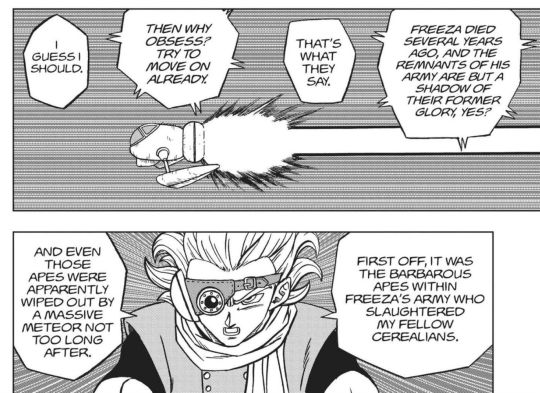
Granolah’s been haunted by the invasion ever since, but there’s nothing he can do about it. Frieza wiped out the Saiyans a long time ago, and then Frieza got killed after that, so there’s no one left for Granolah to take revenge upon, even if he were powerful enough to take revenge. When I first heard about this guy, I was skeptical of the concept, since his vendetta would be forty or fifty years old by this time. But with Granolah, that’s the point. He’s been holding on to this grudge the whole time, and when he gets his chance to act, he grabs it with both hands.

Meanwhile, Goku and Vegeta are still training on Beerus’ planet. Goku learned to use Ultra Instinct at will during the Moro crisis, but Whis explains that this is only the beginning. Goku still can’t sustain UI for very long, while Merus could do it all the time. And Whis is even better at UI than Merus was, and the Grand Minister is even better still. So Goku has a long way to go, which is fine by him.

Vegeta, however, has no interest in learning Ultra Instinct, since he concluded some time ago that the ability doesn’t suit his tendency to overthink things. He wants to surpass Goku in some other way, and Beerus offers him a glimmer of hope, saying that there’s more than one godly technique that he can learn. The angels uses Ultra Instinct, but the Gods of Destruction follow a different path. Beerus says he’s not interested in teaching Vegeta, but then he teaches him anyway, because Beerus is tsundere. “I-it’s not like I want to teach you how to use destruction ki or anything, baka!”
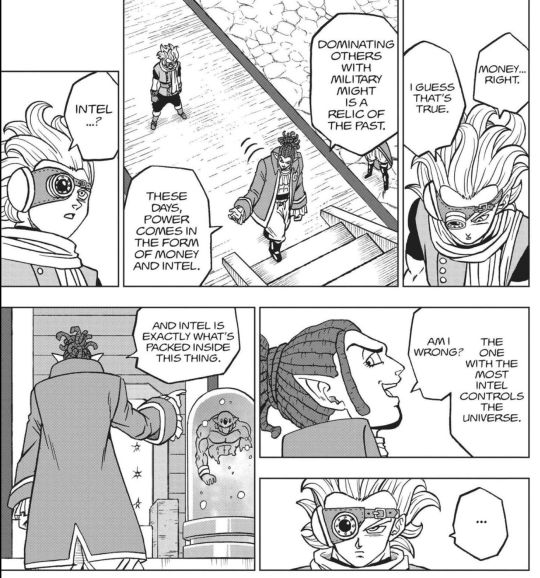
Back to Granolah. At the end of the Moro arc, we met Granolah as he was stealing Seven Three’s remains from the aliens who built him. Seven Three was part of a whole series of similar androids, but he was the only one who spent any time in the field, so he’s a lot more powerful from the life experiences he had. Granolah’s client, Elec, could use Seven Three as the template for an army of unstoppable androids, but that’s not why he wanted the android. Elec’s what you might call an information broker, and he plans to mine Seven Three’s memory banks to find some useful data.
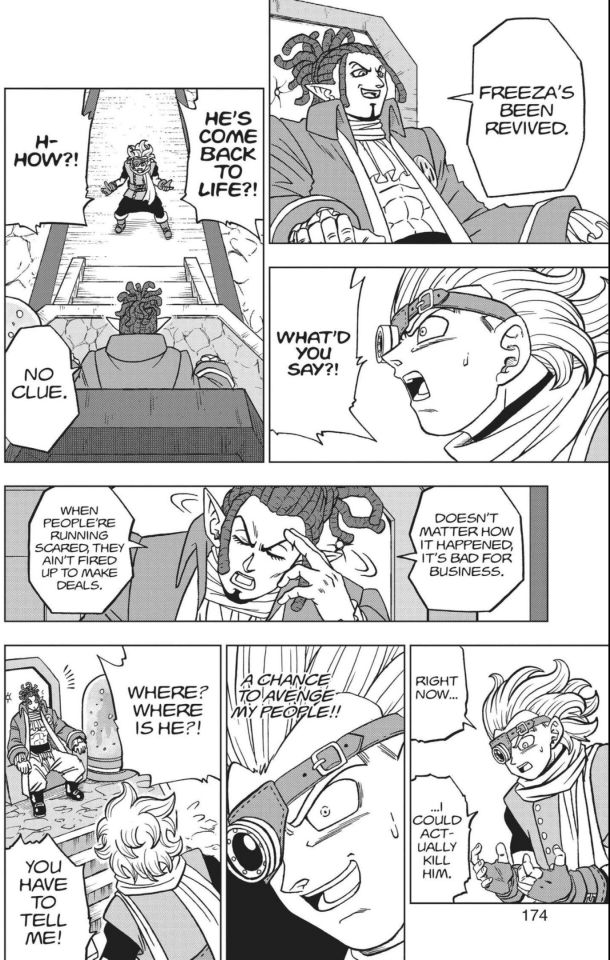
Granolah asks about his next assignment, but Elec doesn’t have any new work lined up, due to Frieza’s return to the galactic stage. We’ve only gotten glimpses of what Frieza’s been up to since Whis re-revived him at the end of the Tournament of Power. But apparently his activities have upset the status quo, and that’s hurting Elec’s business. That doesn’t matter to Granolah, though, and he immediately demands to know where Freiza is. Elec has his associates clobber him a little to get him back in line. He convinces Granolah that he doesn’t need to run off half-cocked, and Granolah backs down and heads home.
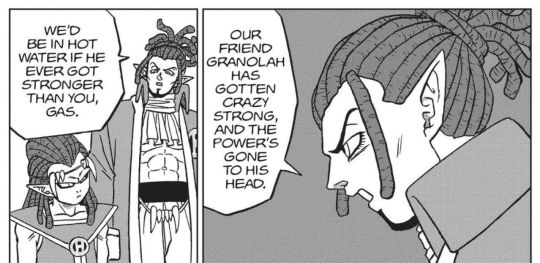
After he leaves, the rest of Elec’s group, the Heeters, ask Elec why he would tell Granolah about Frieza at all. They know how he feels about Frieza, so why stir the pot? Elec explains that Granolah’s getting too powerful, and if he ever surpassed the Heeters’ strongest member, Gas, then that might lead to trouble. The Heeters doubt that anyone could surpass Gas, but Elec still doesn’t want to take any chances.

So he wants Granolah good and riled up, so that when the time is right, he can manuever Granolah into a fight he can’t win, and Frieza will finish off Granolah for him.

Meanwhile, on the way home, Granolah gets ambushed by one of his fellow bounty-hunter guys, who wants to steal the big payday Granolah just scored. But Granolah has him completely outclassed. First he uses his eye-piece/computer, Oatmeel, as a decoy, and then Granolah picks off all of this guy’s allies with his sniper technique. Granolah’s species, the Cerealians, have a specialized right eye that gives them exceptional vision.
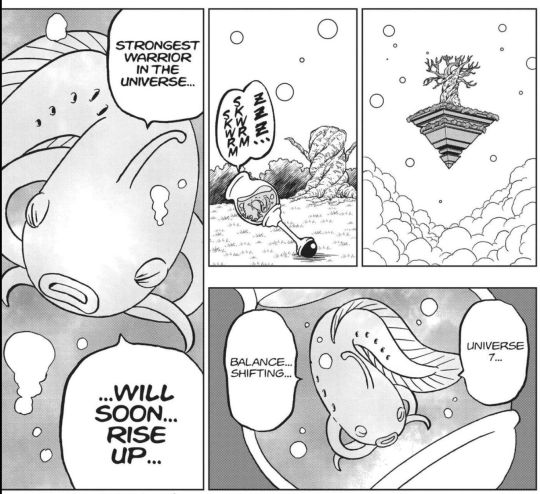
So Granolah’s powerful, sure, but he’s no match for Frieza, right? Well, Granolah plans to do something about that. As he schemes, the Oracle Fish on Beerus’ planet has a prophetic vision that the “strongest warrior in the universe will soon rise up.”

Back to Granolah, we find that he’s still living on Planet Cereal, even after the rest of his people were wiped out by the Saiyans. Since then, the planet has been re-populated by another species, the Sugurians, who lost their own homeworld at some point. The Heeters brokered a deal to settle them on Cereal, and their domed cities are built right next to the ruins of the Cerealian cities. I really like this imagery. Like I said, I was kind of wary of the idea of an alien seeking revenge after so many decades, but this story really uses that passage of time to full effect.
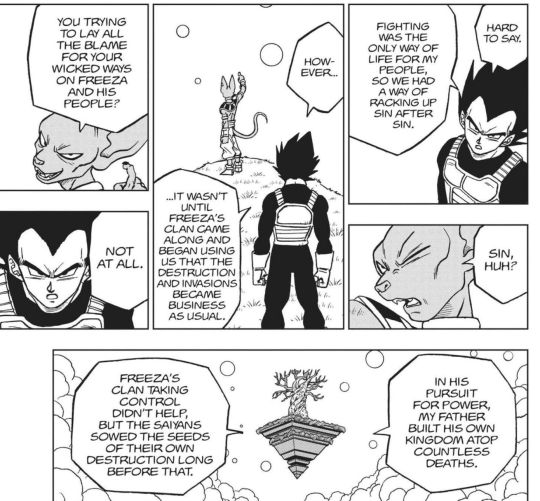
Meanwhile, Beerus talks to Vegeta about the Saiyans, and Vegeta admits that their destructive tendencies led to their downfall. Frieza accelerated the process, but his own father, King Vegeta III, is the one Vegeta holds responsible.
I’ve often noted this, but I find Vegeta to be an unreliable narrator for Saiyan history. In most stories, he’s literally the only one who remembers the Saiyan race, so his perspective is treated as gospel simply because there’s no one else to dispute it. In this case, I think Vegeta’s putting too much blame on his dad. I’m sure Vegeta I and Vegeta II bear their own responsibility, and it probably goes back even further than that. But Vegeta III is the leader he remembers, so it makes sense he would see it that way.
But he’s still wrong. Remember the Super Saiyan God legend from the Battle of Gods movie. The hero of the tale was trying to wipe out the wicked Saiyans, and he failed. That story was so ancient that Vegeta didn’t even know about it, which just goes to show that the Saiyans’ problems are far older than his dynasty.

And I guess this is what sets off Beerus’ bullshit-meter, since he dismisses Vegeta’s answer as ridiculous. He accuses Vegeta of putting the sins of his people on his own shoulders, and even if he were responsible, why do those old crimes have anything to do with his life now? He then reveals that he was the one who gave Frieza the idea to destroy Planet Vegeta all those years ago. Vegeta flies into a rage, but he can’t beat Beerus any more now than he could when they first fought on Earth.

Beerus’ point is that Vegeta will have to let go of the past if he hopes to master the style of the Gods of Destruction. This is kind of like what Toppo had to do when he transformed into a Destroyer in the Tournament of Power. He had been trying to avoid that step for a long time, but when he got desperate enough, he finally crossed the threshold, and Vegeta mocked him for it.
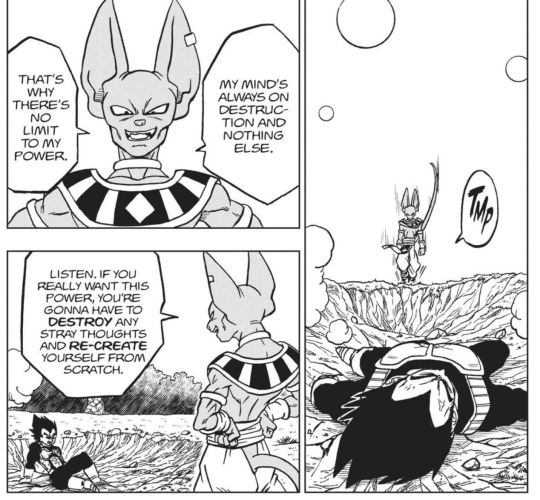
And now Beerus is mocking Vegeta for failing to understand this. Toppo got stronger because he put aside the irrelevancies and focused on what mattered. Beerus says he only focuses on destruction, which keeps him sharp. His advice to Vegeta is that he’ll have to destroy his own stray thoughts to build himself into something better.
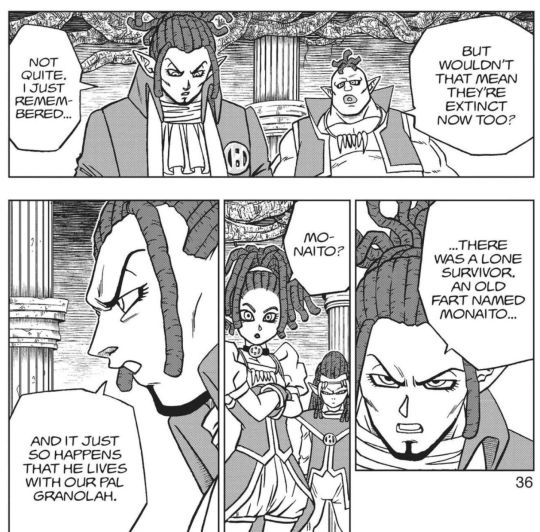
Meanwhile, the Heeters go through Seven Three’s memory records and learn what they wanted to know: the location of Zuno, the galaxy’s greatest information broker. But they also learn about Moro and the Dragon Balls, since Seven Three was involved with that business before he got captured. Elec realizes that the Dragon Balls might explain how Frieza came back to life, and Macki recalls that there used to be Namekians on Planet Cereal before they got wiped out. But Elec knows that there’s one left: Granolah’s housemate, Monaito.

Back on Cereal, Granolah discusses his latest job with Monaito, and informs him of Frieza’s return. The two of them live in this remote house, far from the Cerealian ruins and the Sugurian cities. Even though they’re on friendly terms with the Sugurians, they prefer to be removed from their tragic past. I find it off that their house doesn’t look much like the Cerealian or Namekian architecture. Maybe the Sugurians built it for them.
Anyway, Granolah considers using the Dragon Balls to become powerful enough to defeat Frieza, but Monaito warns him that the Dragon Balls aren’t meant for revenge. Besides, they don’t have a complete set on planet Cereal. One is in Monaito’s house, but the other was lost a long time ago. Wait, what?

To explain how Monaito has his own set of Dragon Balls, we cut to a lesson on New Namek, where Moori explains how Namekians have settled on other planets. Those communities would have their own elders, just as Moori is the elder of New Namek. And those elders would be empowered to create and maintain Dragon Balls.
This isn’t exactly news, since this is exactly how we have Dragon Balls on Earth. The Son of Katas came to Earth as a refugee, then eventually ascended to the role of Kami and created a set of Dragon Balls without remembering where he learned to do it. Monaito’s basically the same deal, except he had a whole group of Namekians with him on Cereal, and he’s the only one who survived the invasion. This story just confirms that there could be other Namekian communities in the universe, and any of them could have their own sets of Dragon Balls.

What I find more troubling is that Monaito’s set of Dragon Balls is just a pair. I guess there’s no rule that their must be seven, but it’s kind of weird how we’ve always seen them in groups of seven before, and yet this one is just two.
Anyway, as fate would have it, Granolah turns on the local news and learns that some Sugarian kid just happened to find the lost ball and took it to a lab for study. And maybe this is why they went with just two balls, in order to simplify this moment, but they could have just as easily put six Dragon Balls on Monaito’s shelf.

So Granolah immediately makes his move, stealing the second Dragon Ball and sneaking off to make his wish. I like the design for Cereal’s Shenron, or whatever he’s called. The dragon is willing to grant Granolah’s wish to become the greatest warrior in the universe, but Granolah’s body isn’t sturdy enough for that kind of power. However, the Dragon can make it possible, if Granolah is willing to accept a compromise in exchange. Granolah doesn’t even wait to find out what it is.
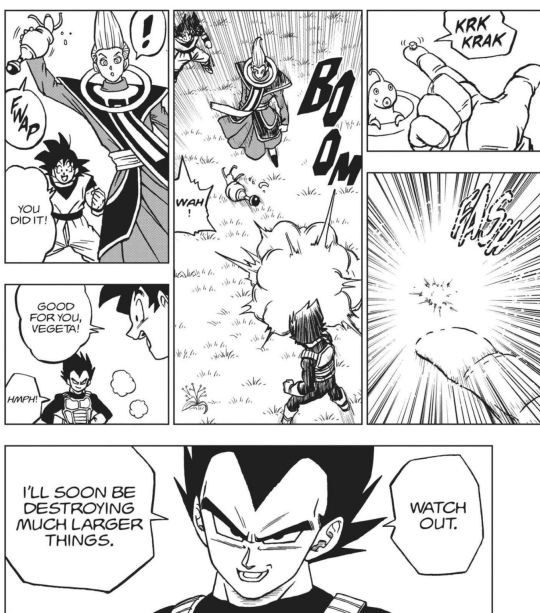
Meanwhile, Vegeta has finally achieved some success in using the Hakai technique. He can only destroy little grains of sand, but he can destroy them, which is a big accomplishment. And he’s not going to rest on his laurels.
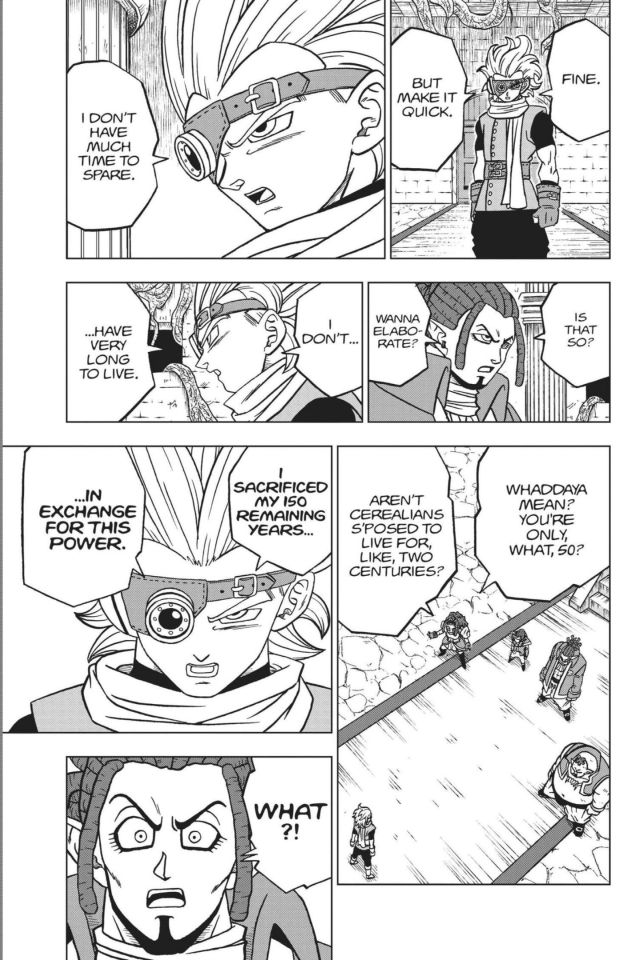
Satisfied that his wish has been granted, Granolah immediately heads back to the Heeter’s HQ and demands to know where he can find Frieza. The Heeters don’t understand what’s happened to him, but Granolah quickly defeats Oil and Macki in combat, and Elec realizes that Granolah’s not just blowing smoke. Maybe he really can defeat Frieza, but he can’t just tell him where to find Frieza, because if he loses, Frieza might take revenge on the Heeters. So Elec asks for some information on how Granolah got this strong, and Granolah explains the Dragon Balls and the condition he had to agree to. Normally, Cerealians live for two hundred hears, and Granolah’s 50 now, but in order to get his wish, he had to let the Dragon shorten his lifespan. Granolah now has only three years left to live.

Elec convinces Granolah to wait on Planet Cereal while they track down Frieza’s position. In reality, Elec hatches a scheme to neutralize Granolah first. Elec wants Frieza out of the picture, but he’s worried that if Granolah does the job, he might wipe out Frieza’s goon squad, and Elec wants to take them over for his own organization. Wait, why didn’t the Heeters take over the Frieza Force before, when Frieza was dead? I mean, it’s just as well that they didn’t do this, since Frieza would have returned and killed them, but they didn’t know that at the time.

So how can Elec stop Granolah from wrecking his plans? Simple, he’s going to get Goku and Vegeta to do it for him. Having studied Seven Three’s records, Elec knows that the Saiyans fought Moro, and they should be powerful enough to defeat Granolah, and Granolah won’t turn down a chance to fight Saiyans, since he wants revenge against those guys too. Elec is confident that Goku and Vegeta would win that fight, but what if he’s wrong? Well, I guess he’s got nothing to lose by trying...
So yeah, to repeat what I said at the top, this is way, way better than the Moro arc. There’s a lot fewer characters, and their motive are more complex, and their plans aren’t nearly as convoluted. We’re not sending Goku and Vegeta on a wild goose chase to like five different planets for this one. No dead-end subplots about Majin Buu or those space crooks who tried to rob that space train.
I also really like the way this story uses Frieza without featuring him in the plot. The problem I’ve always had with bringing back Frieza is that he just does all the same stuff he did the first time around. The only novelty to Frieza these days is less about what he’s up to, but how everyone else reacts to his return. The Heeters, Granolah, Monaito, and the Sugarians have been trying to build a life for themselves in a post-Frieza universe, but now he’s back, and that upsets everything.
Also, it’s refreshing to see Goku and Vegeta actually learning something on Beerus’ planet, as opposed to just sparring there as an establishing scene. I’m looking forward to seeing how this plays out.
#dragon ball#dragon ball super manga#2023dbapocryphaliveblog#goku#vegeta#beerus#whis#granolah#elec#oil#gas#macki#monaito#moori
26 notes
·
View notes